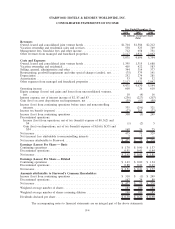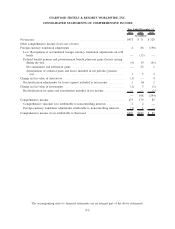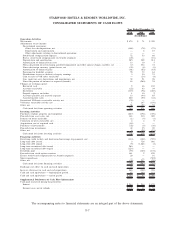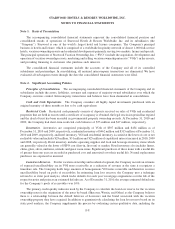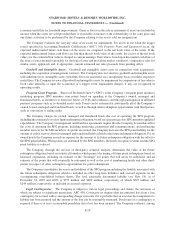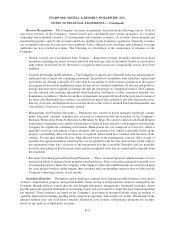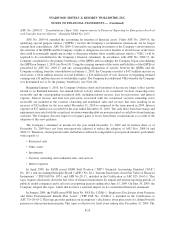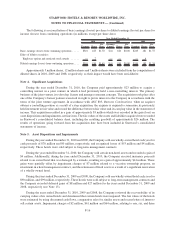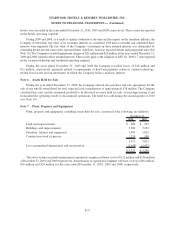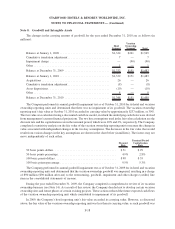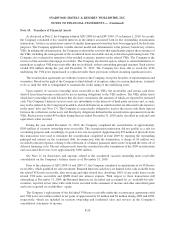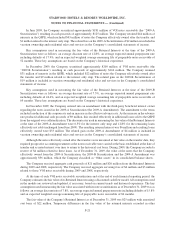Starwood 2010 Annual Report Download - page 129
Download and view the complete annual report
Please find page 129 of the 2010 Starwood annual report below. You can navigate through the pages in the report by either clicking on the pages listed below, or by using the keyword search tool below to find specific information within the annual report.Costs Incurred to Sell VOIs. The Company capitalizes direct costs attributable to the sale of VOIs until the
sales are recognized. Selling and marketing costs capitalized under this methodology were approximately $3 million
as of December 31, 2010 and 2009, respectively, and all such capitalized costs are included in prepaid expenses and
other assets in the accompanying consolidated balance sheets. Costs eligible for capitalization follow the guidelines
of ASC 978, Real Estate — Time Sharing Activities. If a contract is cancelled, the Company charges the
unrecoverable direct selling and marketing costs to expense and records forfeited deposits as income.
VOI and Residential Inventory Costs. Real estate and development costs are valued at the lower of cost or
net realizable value. Development costs include both hard and soft construction costs and together with real estate
costs are allocated to VOIs and residential units on the relative sales value method. Interest, property taxes and
certain other carrying costs incurred during the construction process are capitalized as incurred. Such costs
associated with completed VOI and residential units are expensed as incurred.
Advertising Costs. The Company enters into multi-media ad campaigns, including television, radio, internet
and print advertisements. Costs associated with these campaigns, including communication and production costs,
are aggregated and expensed the first time that the advertising takes place. If it becomes apparent that the media
campaign will not take place, all costs are expensed at that time. During the years ended December 31, 2010, 2009
and 2008, the Company incurred approximately $132 million, $118 million and $146 million of advertising
expense, respectively, a significant portion of which was reimbursed by managed and franchised hotels.
Retained Interests. The Company periodically sells notes receivable originated by its vacation ownership
business in connection with the sale of VOIs. The Company, prior to the adoption of ASU 2009-17, would retain
interests in the assets transferred to qualified and non-qualified special purpose entities (“Retained Interests”),
which were accounted for as over-collateralizations and interest only strips. These retained interests were treated as
“available-for-sale” transactions under the provisions of ASC 320 Investments — Debt and Equity Securities. The
Company reported changes in the fair values of these Retained Interests considered temporary through the
accompanying consolidated statement of comprehensive income. A change in fair value determined to be
other-than-temporary was recorded as a loss in the Company’s consolidated statement of income. The Company
had Retained Interests of $25 million at December 31, 2009. Additionally, as of December 31, 2009, the Company
had $56 million of notes retained after the 2009 note sales.
Use of Estimates. The preparation of financial statements in conformity with accounting principles gen-
erally accepted in the United States requires management to make estimates and assumptions that affect the
reported amounts of assets and liabilities and disclosure of contingent assets and liabilities at the date of the
financial statements and the reported amounts of revenues and expenses during the reporting period. Actual results
could differ from those estimates.
Reclassifications. Certain reclassifications have been made to the prior years’ financial statements to
conform to the current year presentation
Impact of Recently Issued Accounting Standards.
Adopted Accounting Standards
In July 2010, the Financial Accounting Standards Board (“FASB”) issued Accounting Standards Update
(“ASU”) No. 2010-20, “Receivables (Topic 310): Disclosures about the Credit Quality of Financing Receivables
and the Allowance for Credit Losses.” This topic requires disclosures of financing receivables and allowance for
credit losses on a disaggregated basis. The balance sheet related disclosures are required beginning at December 31,
2010 and the statements of income disclosures are required, beginning for the three months ended March 31, 2011
(see Note 11).
In June 2009, the FASB issued ASU No. 2009-16, “Transfers and Servicing (Topic 860): Accounting for
Transfers of Financial Assets” (formerly Statement of Financial Accounting Standards (“SFAS”) No. 166), and
F-13
STARWOOD HOTELS & RESORTS WORLDWIDE, INC.
NOTES TO FINANCIAL STATEMENTS — (Continued)



